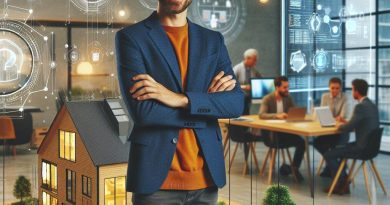Green Buildings: Future of Offices?
Last Updated on November 20, 2023
Introduction
Defining green buildings as structures designed with a focus on environmental sustainability, the contemporary surge in consciousness regarding our ecological impact has brought sustainability to the forefront of architectural considerations.
The rise of sustainability reflects an evolving ethos, a collective acknowledgment of the need to harmonize human habitation with the planet’s well-being.
This paradigm shift is not merely an architectural trend but a conscientious response to the escalating environmental challenges we face.
In this context, the importance of green buildings becomes paramount, serving as proactive contributors to addressing climate change and curbing the carbon footprint associated with conventional structures.
Their significance extends beyond mere architectural innovation; green buildings embody a commitment to responsible practices that align with global efforts for a healthier planet.
As we delve into the sections ahead, we’ll unravel the multifaceted dimensions of green buildings, exploring their environmental impact and their potential to redefine the future landscape of offices.
Benefits of Green Buildings
- Energy efficiency and reduced energy consumption
- Cost savings on utilities
- Improved indoor air quality
- Health and well-being of occupants
- Increased productivity and employee satisfaction
Green buildings have become increasingly popular in recent years, and for good reason.
These innovative structures offer a range of benefits, all of which contribute to a more sustainable and environmentally friendly future.
Energy efficiency and reduced energy consumption
One significant advantage of green buildings is their energy efficiency. Designed with advanced technology and materials, these buildings are able to reduce energy consumption significantly.
By optimizing insulation, smart lighting systems, and efficient air conditioning, green buildings not only save energy but also help to combat climate change.
Cost savings on utilities
Another advantage is the cost savings on utilities. Due to their energy-efficient features, green buildings require less energy for heating, cooling, and lighting.
As a result, businesses and residents can enjoy reduced utility bills, saving money in the long run.
Improved indoor air quality
Improved air quality is also a key benefit of green buildings.
Traditional buildings can often contain pollutants such as mold, dust, and volatile organic compounds, which can have detrimental effects on occupants’ health.
However, green buildings incorporate strategies to improve indoor air quality, such as the use of low-emission materials and increased ventilation.
This leads to healthier and more productive environments for occupants.
Health and well-being of occupants
The health and well-being of occupants are given high priority in green buildings.
They are designed to promote physical and mental wellbeing, with features such as natural lighting, biophilic design, and access to green spaces.
Studies have shown that exposure to natural light and greenery can enhance mood, reduce stress levels, and increase overall satisfaction and happiness among occupants.
Increased productivity and employee satisfaction
Defining green buildings as structures designed with a focus on environmental sustainability.
The contemporary surge in consciousness regarding our ecological impact has brought sustainability to the forefront of architectural considerations.
The rise of sustainability reflects an evolving ethos, a collective acknowledgment of the need to harmonize human habitation with the planet’s well-being.
This paradigm shift is not merely an architectural trend but a conscientious response to the escalating environmental challenges we face.
In this context, the importance of green buildings becomes paramount, serving as proactive contributors to addressing climate change and curbing the carbon footprint associated with conventional structures.
Their significance extends beyond mere architectural innovation; green buildings embody a commitment to responsible practices that align with global efforts for a healthier planet.
As we delve into the sections ahead, we’ll unravel the multifaceted dimensions of green buildings, exploring their environmental impact and their potential to redefine the future landscape of offices.
Trends in Green Buildings
When it comes to green buildings, there are several trends that are shaping the future of offices:
Integration of renewable energy sources
One major trend in green buildings is the integration of renewable energy sources. This includes the use of solar panels, wind turbines, and geothermal systems to generate clean and sustainable energy.
Use of sustainable materials and construction techniques
Another trend is the use of sustainable materials and construction techniques.
This includes using recycled or reclaimed materials, such as bamboo or reclaimed wood, and implementing energy-efficient insulation and building systems.
Water conservation and efficient plumbing systems
Water conservation is also a key focus in green buildings.
This involves the use of efficient plumbing systems, such as low-flow toilets and faucets, as well as the incorporation of rainwater harvesting and greywater recycling systems.
Smart technologies for monitoring and optimizing energy usage
Smart technologies have become increasingly popular in green buildings.
These technologies allow for the monitoring and optimization of energy usage, such as using sensors to adjust lighting or HVAC systems based on occupancy or weather conditions.
Biophilic design and incorporation of natural elements
Finally, biophilic design and the incorporation of natural elements are growing trends in green buildings.
This includes the use of natural lighting, indoor plants, and outdoor green spaces to create a more sustainable and inviting work environment.
Overall, these trends in green buildings are shaping the future of offices by prioritizing sustainability, energy efficiency, and the well-being of occupants.
Integrating renewable energy sources, using sustainable materials, conserving water, implementing smart technologies, and incorporating natural elements all contribute to creating healthier and more environmentally-friendly workspaces.
As the world becomes more conscious of the impact of buildings on the environment, the adoption of these trends will continue to rise.
Green buildings are not only beneficial for the planet but also offer numerous advantages to businesses, including lower operating costs, increased employee productivity, and improved brand reputation.
Ultimately, the future of offices lies in green buildings.
These buildings integrate renewable energy sources, utilize sustainable materials and construction techniques, conserve water, employ smart technologies, and incorporate natural elements.
By embracing these trends, businesses can create more sustainable and welcoming work environments while reaping the benefits of reduced costs and increased productivity.
Read: Tech Impact on Commercial Properties
Challenges in Adopting Green Buildings
- High upfront costs and return on investment: Implementing green building practices can require significant initial investment.
- Lack of awareness and education: Many people are unaware of the benefits and importance of green buildings.
- Resistance to change and conventional practices: People are often hesitant to embrace new practices and deviate from traditional building methods.
- Regulatory and policy constraints: In some locations, there may be regulations that discourage or hinder the adoption of green building practices.
- Availability of skilled professionals and green building certifications: There is a shortage of professionals with expertise in green building techniques.
Adopting green buildings, although promising, comes with numerous challenges that need to be addressed. The following list outlines some of the key obstacles faced in the industry:
High upfront costs and return on investment
The initial capital required to incorporate green building features can be significantly higher compared to traditional buildings. This can deter investors and developers who prioritize short-term financial gains.
Lack of awareness and education
Many potential building owners, investors, and end-users are not fully aware of the benefits and importance of green buildings.
Promoting education and raising awareness about the environmental and economic advantages is crucial to overcome this obstacle.
Resistance to change and conventional practices
The construction industry has long relied on conventional building practices, and change can be met with resistance.
Convincing stakeholders to adopt sustainable approaches requires substantial efforts in showcasing the long-term benefits and dispelling misconceptions.
Regulatory and policy constraints
In some regions, existing regulations and policies may not be favorable to green building initiatives.
Government support through incentives, tax breaks, and updated policies can play a pivotal role in encouraging the adoption of green practices.
Availability of skilled professionals and green building certifications
Green building practices require specialized knowledge and skills.
The shortage of professionals trained in sustainable design, construction, and operation poses a challenge.
The availability and accessibility of green building certifications and training programs need to be increased.
To sum it up, while green buildings hold immense promise for a sustainable future, several challenges must be addressed to facilitate their widespread adoption.
Overcoming the high upfront costs, increasing awareness and education, addressing resistance to change, adapting regulations and policies.
And enhancing the availability of skilled professionals are crucial steps towards realizing the potential of green buildings.
Read: US Retail Spaces: Evolution & Trends

Success Stories and Case Studies
In recent years, there has been a growing trend towards green buildings as the future of offices.
Companies and organizations are realizing the numerous benefits associated with implementing green building practices.
Through success stories and case studies, we can see how these practices have positively impacted the environment, cost savings, and employee satisfaction and productivity.
Examples of companies or organizations that have successfully implemented green building practices
Google is known for its commitment to sustainability and green building practices.
The company has implemented various strategies, such as incorporating renewable energy sources, optimizing energy efficiency, and utilizing sustainable materials in their office buildings.
This has not only reduced their carbon footprint but has also resulted in significant cost savings.
Apple
Apple’s new headquarters, Apple Park, is an example of green building practices at its finest.
The campus runs on 100% renewable energy and incorporates energy-efficient technologies, such as solar panels and a natural ventilation system.
The building’s landscaping also focuses on native plants and water conservation. Apple sets an example of how large-scale organizations can embrace sustainability in their office design.
Positive impact on the environment and cost savings
Reduced carbon footprint
Green buildings significantly reduce greenhouse gas emissions by utilizing renewable energy sources, implementing energy-efficient technologies, and adopting sustainable materials.
This helps combat climate change and contributes to a healthier environment.
Energy efficiency
Green buildings are designed to optimize energy consumption and reduce wastage.
From advanced insulation systems to energy-efficient lighting and HVAC systems, these buildings consume less energy, resulting in substantial cost savings for companies in the long run.
Water conservation
Green buildings employ various water-saving techniques, such as rainwater harvesting, water-efficient fixtures, and landscaping designs that promote water retention.
This not only reduces the strain on local water resources but also helps companies save on water bills.
Increased employee satisfaction and productivity
Healthier work environment
Green buildings prioritize the well-being of occupants by improving indoor air quality, incorporating natural lighting, and using non-toxic building materials.
This healthier work environment leads to reduced sick days and increased overall productivity and satisfaction among employees.
Enhanced comfort
Green buildings focus on thermal comfort, acoustics, and ergonomic design.
By providing a comfortable and pleasant workspace, these buildings contribute to higher employee satisfaction and well-being, leading to improved productivity.
Employee engagement
The implementation of green building practices often involves active employee participation through sustainability programs and initiatives.
Engaging employees in these practices fosters a sense of purpose and connection to the company, boosting their motivation and job satisfaction.
Ultimately, green buildings have emerged as the future of offices due to their numerous benefits.
Success stories and case studies of companies like Google and Apple illustrate the positive impact on the environment, cost savings, and increased employee satisfaction and productivity.
As more organizations recognize these advantages, the demand for green buildings is expected to continue rising, shaping the future of our workplaces.
Read: Navigating Industrial Real Estate Today
Future Outlook
- Growing demand and market for green buildings
- Government initiatives and incentives
- Advancements in technology and sustainable practices
- Role of real estate developers and industry stakeholders in promoting green buildings
Growing demand and market for green buildings
The future of office spaces lies in green buildings. With an increasing awareness about environmental sustainability, there is a growing demand for buildings that minimize their impact on the environment.
This demand has created a strong market for green buildings.
Government initiatives and incentives
Government initiatives and incentives play a crucial role in promoting the adoption of green buildings.
Many governments across the world have introduced regulations and policies that encourage developers and businesses to construct and operate eco-friendly buildings.
These initiatives include tax benefits, grants, and certification programs.
Advancements in technology and sustainable practices
Advancements in technology have also contributed to the rise of green buildings.
Innovations such as solar panels, energy-efficient heating and cooling systems, and smart building management systems have made it easier for developers to create sustainable spaces.
These technologies not only reduce the environmental footprint but also lead to cost savings in the long run.
Furthermore, sustainable practices in building construction have become more prevalent.
From using recycled materials and implementing efficient waste management systems to incorporating natural lighting and ventilation.
Developers are employing various strategies to minimize the environmental impact of their projects.
Role of real estate developers and industry stakeholders in promoting green buildings
Real estate developers and other industry stakeholders play a pivotal role in the promotion of green buildings.
As they are responsible for the construction and management of properties, their choices and actions significantly impact the sustainability of the built environment.
By incorporating green building practices into their projects, developers can contribute to a more sustainable future.
Moreover, industry organizations and associations are actively advocating for green buildings.
They provide resources, training, and certifications to educate developers and professionals about sustainable design, construction, and operation.
These efforts help create a more knowledgeable and skilled workforce that can champion green building practices.
On a final note, the future of offices is undoubtedly tied to eco-friendly buildings.
The increasing demand, coupled with government initiatives and advancements in technology, has created a fertile ground for the growth of eco-friendly buildings.
Real estate developers and industry stakeholders have a crucial role to play in driving this transformation.
By embracing sustainable practices, they can ensure a healthier and more environmentally conscious built environment for future generations.
Read: Retail Property Outlook: A 2024 Review
Conclusion
Recapping the transformative journey through the realm of green buildings unveils a tapestry woven with benefits.
These eco-conscious structures not only prioritize energy efficiency but also foster healthier work environments, promoting the well-being of occupants.
Delving into the role of green buildings in shaping the future of offices, it becomes evident that they serve as architectural ambassadors of sustainability.
Beyond their immediate advantages, they act as catalysts for a paradigm shift in the way we conceptualize and interact with office spaces.
Furthermore, recognizing the importance of sustainable practices becomes integral in the broader context of the real estate industry’s development.
The adoption of eco-friendly principles in building design and construction not only aligns with global environmental goals but also positions the real estate sector as a key player in fostering a greener, more sustainable future.
As we conclude this exploration, the imperative is clear: green buildings are not just structures; they are the cornerstones of a more sustainable and responsible trajectory for the entire real estate industry.


